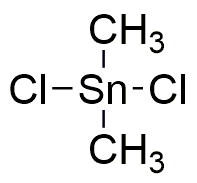Dimethyltin dichloride is widely utilized in research focused on
- Polymer Production: It serves as a catalyst in the synthesis of organotin polymers, which are used in coatings, adhesives, and sealants, providing enhanced durability and resistance to environmental factors.
- Agricultural Applications: This compound is employed as a biocide in agricultural formulations, helping to protect crops from pests and diseases while being less harmful to beneficial organisms compared to traditional pesticides.
- Pharmaceutical Development: In the pharmaceutical industry, it is used in the synthesis of various organotin compounds that exhibit potential anti-cancer properties, offering researchers new avenues for drug development.
- Environmental Remediation: Dimethyltin dichloride is utilized in the treatment of contaminated sites, particularly for the removal of heavy metals, making it a valuable tool for environmental scientists.
- Research in Organometallic Chemistry: It is a key reagent in studies of organometallic compounds, helping researchers explore new chemical reactions and properties that can lead to innovative applications in materials science.
General Information
Properties
Safety and Regulations
Applications
Dimethyltin dichloride is widely utilized in research focused on
- Polymer Production: It serves as a catalyst in the synthesis of organotin polymers, which are used in coatings, adhesives, and sealants, providing enhanced durability and resistance to environmental factors.
- Agricultural Applications: This compound is employed as a biocide in agricultural formulations, helping to protect crops from pests and diseases while being less harmful to beneficial organisms compared to traditional pesticides.
- Pharmaceutical Development: In the pharmaceutical industry, it is used in the synthesis of various organotin compounds that exhibit potential anti-cancer properties, offering researchers new avenues for drug development.
- Environmental Remediation: Dimethyltin dichloride is utilized in the treatment of contaminated sites, particularly for the removal of heavy metals, making it a valuable tool for environmental scientists.
- Research in Organometallic Chemistry: It is a key reagent in studies of organometallic compounds, helping researchers explore new chemical reactions and properties that can lead to innovative applications in materials science.
Documents
Safety Data Sheets (SDS)
The SDS provides comprehensive safety information on handling, storage, and disposal of the product.
Product Specification (PS)
The PS provides a comprehensive breakdown of the product’s properties, including chemical composition, physical state, purity, and storage requirements. It also details acceptable quality ranges and the product's intended applications.
Certificates of Analysis (COA)
Search for Certificates of Analysis (COA) by entering the products Lot Number. Lot and Batch Numbers can be found on a product’s label following the words ‘Lot’ or ‘Batch’.
*Catalog Number
*Lot Number
Certificates Of Origin (COO)
This COO confirms the country where the product was manufactured, and also details the materials and components used in it and whether it is derived from natural, synthetic, or other specific sources. This certificate may be required for customs, trade, and regulatory compliance.
*Catalog Number
*Lot Number
Safety Data Sheets (SDS)
The SDS provides comprehensive safety information on handling, storage, and disposal of the product.
DownloadProduct Specification (PS)
The PS provides a comprehensive breakdown of the product’s properties, including chemical composition, physical state, purity, and storage requirements. It also details acceptable quality ranges and the product's intended applications.
DownloadCertificates of Analysis (COA)
Search for Certificates of Analysis (COA) by entering the products Lot Number. Lot and Batch Numbers can be found on a product’s label following the words ‘Lot’ or ‘Batch’.
*Catalog Number
*Lot Number
Certificates Of Origin (COO)
This COO confirms the country where the product was manufactured, and also details the materials and components used in it and whether it is derived from natural, synthetic, or other specific sources. This certificate may be required for customs, trade, and regulatory compliance.


